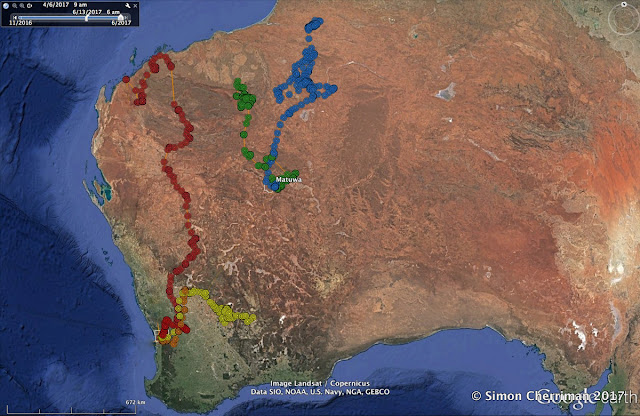I've just returned from Matuwa Indigenous Protected Area in central Western Australia, where a fantastic team of volunteers assisted with my ongoing Goldfields Environmental Management Group-funded research on a breeding 'population' of Walluwurru / Wedge-tailed Eagles. This harsh environment normally has insufficient prey for most of the ~40 pairs of eagles to breed successfully each year, but good rainfall earlier in 2017 resulted in the most productive breeding season recorded since research began in 2012, with an amazing THIRTEEN eaglets hatched! Thanks to the fabulous team from Fortescue Helicopters, we were able to assess the productivity of this 'population' from the air, and it was a fantastic sight to spot 'white specks' on familiar nests from a distance, then hover overhead and confirm the presence of a plump, healthy eaglet!
 |
| A 'white speck' on this Wallu-wurru eyrie is a giveaway that this pair has successfully hatched a chick. |
As part of my PhD research, I fitted GPS/Satellite-transmitters to four of these birds, devices that will allow us to track the eagles' first movements away from their outback nests and beyond. I was lucky enough to actually watch the first flight of one of the tagged eagles 'Kapiburor' (a Martu word for 'stormy/rainy day', pictured above), as he launched from his eyrie on his brand new but powerful set of wings...
 |
| Kapiburor launches on his maiden flight. |
Kapiburor was a lucky find and we managed to fit him with a satellite-transmitter on Friday 13th October, just days before he fledged, before heavy thunderstorm activity set in for the evening. He wasn't the first eagle to be tagged though - five days prior, we were very excited to have located a brood of 'twins' in the neighbouring breeding home range, offspring of our well-known adult male Wedge-tail 'Wallu', who (together with his mate Wurru) was recorded as rearing two chicks successfully for the second time in three years!
 |
| This brood of 'twins' Djootabay (left) and her brother Karlbartu was a highlight of the field trip. |
Above the fenced enclosure was another nest with a single large eaglet, aged about 9 weeks and almost ready to fly. It was wonderful to spend time on country and visit this site with Martu elders and teenage students from the Wiluna Remote Community School, who chose a very appropriate name for the juvenile. 'Yapu', which means 'rock' in Martu Wangka, was named after a fairly large piece of ironstone which I found on the edge of his eyrie, possibly brought in by the adult eagles after being stuck to a large prey item (such as a young kangaroo or Australian Bustard) which could have had sticky, exposed flesh after being left on the ground for several days after being predated. We have recorded rocks in eagle eyries on a few occasions in the past few years, but these have normally been located on failed nests where eggs have been deserted by hungry females and subsequently predated by other birds such as Black-breasted Buzzards (known to use rocks as egg-breaking tools), and possibly crows.
Yapu was fitted with a satellite-transmitter and returned to his eyrie soon afterwards, and we are anticipating his departing flight with great excitement! It will be amazing to follow his progress from the high nest ridge, down to the plain country where his parents hunt, and far beyond when his juvenile dispersal phase begins.
 |
| Yapu, a gorgeous eaglet aged ~9 weeks, was named after a large rock found on his eyrie. |
On the final day of fieldwork I went in to check on Djootabay and Karlbartu and was very pleased to find them both with bulging crops, full of freshly killed rabbit and goanna observed on their eyrie.
 |
| Female eaglets like Karlbartu (left) are much bigger than males. |
This gave me a good opportunity to take photographs of the eagles in the wonderful setting sunlight. Each bird's sex was apparent from its relative head length, with Karlbartu (a female, below left) have a much more elongated cere and exposed bill than Djootabay (a male):
After giving these absolutely stunning birds a 'goodbye and good luck' blessing, I returned to the Matuwa camp to pack up. This was by far the most memorable trip to Martu Country I have been privileged to undertake, being one of high productivity, both for the eagles, my research, and the fabulous friendships forged with more members of the Martu community. As a parting gift for my research and engagement with the locals, I was given a beautiful 'Wantu' - a mat/blanket made by teacher Debbie and teenage girls from Marlu (Red Kangaroo) skin. This fabulous gift brought tears to my eyes and I feel so lucky to be able to work on country with these beautiful people.
 |
| The next generation of Walluwurru researchers! |
 |
| It is always wonderful to spend time with Martu women elders at Matuwa. |
Huge thanks to Dani, Ben, Renae and Kristal ('Team Eagle'!) for dedicating so much time and energy to helping with my research, to the Department of Biodiversity, Conservation and Attractions for their ongoing logistical support, to the GEMG for their wonderful financial support, and of course, to the traditional Martu elders for endorsing this work to be carried out on their ancient land.





















